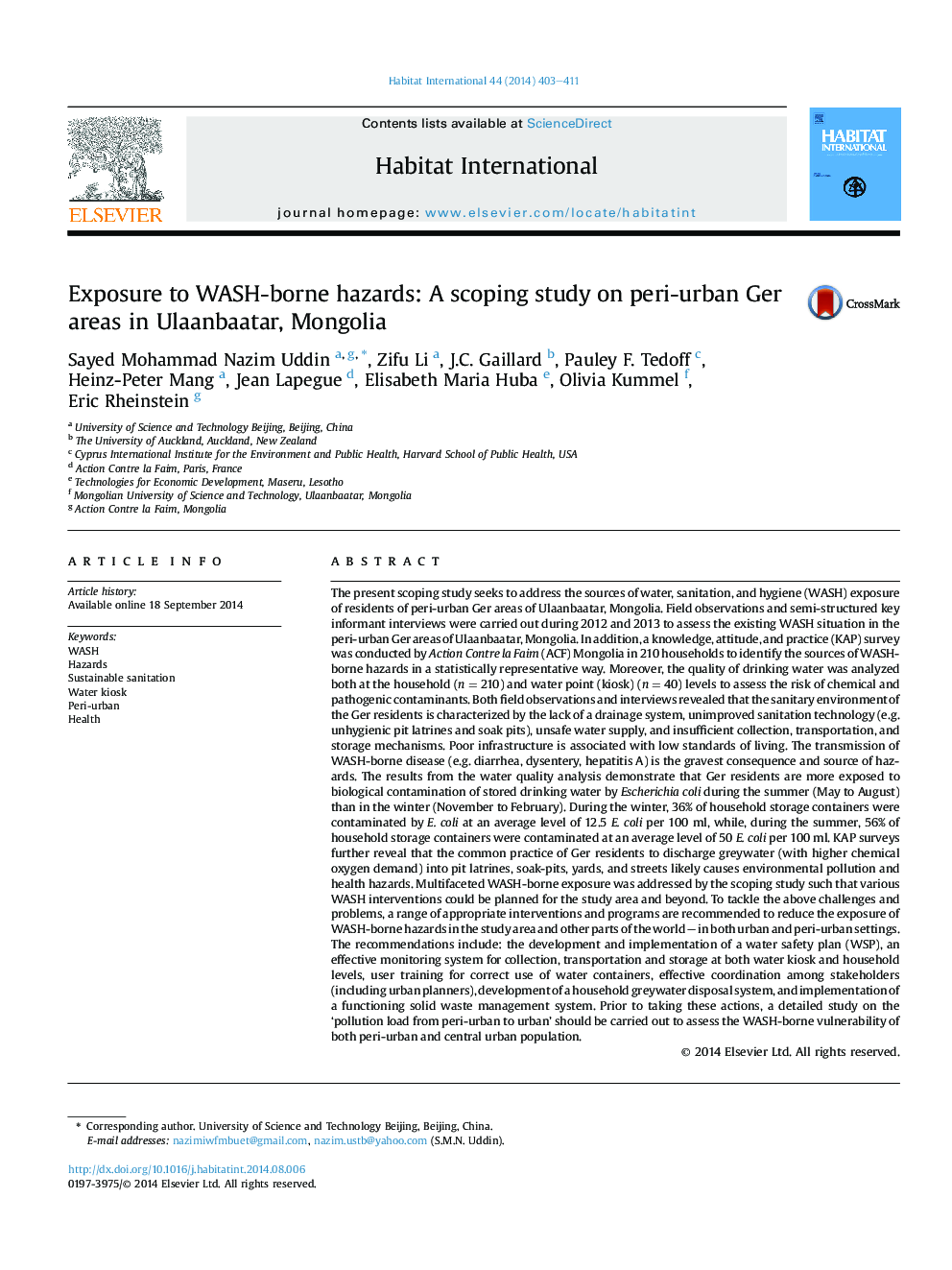| کد مقاله | کد نشریه | سال انتشار | مقاله انگلیسی | نسخه تمام متن |
|---|---|---|---|---|
| 1047789 | 1484498 | 2014 | 9 صفحه PDF | دانلود رایگان |

• Multifaceted WASH-borne exposure was addressed in peri-urban context.
• Poor infrastructure is associated with low standards of living.
• The transmission of WASH-borne diseases is the gravest consequence and source of hazards.
• Summer is more hazardous than winter in terms of biological contaminations.
• Various WASH interventions are recommended to reduce the exposure of WASH-borne hazards.
The present scoping study seeks to address the sources of water, sanitation, and hygiene (WASH) exposure of residents of peri-urban Ger areas of Ulaanbaatar, Mongolia. Field observations and semi-structured key informant interviews were carried out during 2012 and 2013 to assess the existing WASH situation in the peri-urban Ger areas of Ulaanbaatar, Mongolia. In addition, a knowledge, attitude, and practice (KAP) survey was conducted by Action Contre la Faim (ACF) Mongolia in 210 households to identify the sources of WASH-borne hazards in a statistically representative way. Moreover, the quality of drinking water was analyzed both at the household (n = 210) and water point (kiosk) (n = 40) levels to assess the risk of chemical and pathogenic contaminants. Both field observations and interviews revealed that the sanitary environment of the Ger residents is characterized by the lack of a drainage system, unimproved sanitation technology (e.g. unhygienic pit latrines and soak pits), unsafe water supply, and insufficient collection, transportation, and storage mechanisms. Poor infrastructure is associated with low standards of living. The transmission of WASH-borne disease (e.g. diarrhea, dysentery, hepatitis A) is the gravest consequence and source of hazards. The results from the water quality analysis demonstrate that Ger residents are more exposed to biological contamination of stored drinking water by Escherichia coli during the summer (May to August) than in the winter (November to February). During the winter, 36% of household storage containers were contaminated by E. coli at an average level of 12.5 E. coli per 100 ml, while, during the summer, 56% of household storage containers were contaminated at an average level of 50 E. coli per 100 ml. KAP surveys further reveal that the common practice of Ger residents to discharge greywater (with higher chemical oxygen demand) into pit latrines, soak-pits, yards, and streets likely causes environmental pollution and health hazards. Multifaceted WASH-borne exposure was addressed by the scoping study such that various WASH interventions could be planned for the study area and beyond. To tackle the above challenges and problems, a range of appropriate interventions and programs are recommended to reduce the exposure of WASH-borne hazards in the study area and other parts of the world – in both urban and peri-urban settings. The recommendations include: the development and implementation of a water safety plan (WSP), an effective monitoring system for collection, transportation and storage at both water kiosk and household levels, user training for correct use of water containers, effective coordination among stakeholders (including urban planners), development of a household greywater disposal system, and implementation of a functioning solid waste management system. Prior to taking these actions, a detailed study on the ‘pollution load from peri-urban to urban’ should be carried out to assess the WASH-borne vulnerability of both peri-urban and central urban population.
Journal: Habitat International - Volume 44, October 2014, Pages 403–411